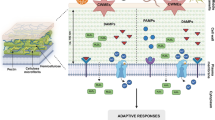Abstract
Two different types of bioelectric potential changes have been registered in the style of Lilium longiflorum cv. Arai 5 after different treatments of the stigma. Self-pollination induces a bioelectric potential change different from the potential change induced by cross-pollination. Removal of the stigma or apllication of killed compatible pollen induced a bioelectrical response similar to the potential change recorded after cross-pollination. No bioelectric potential change was recorded after application of pollen of Petunia hybrida, pollen of Haemanthus katherinae, killed self-pollen, or no treatment at all.
The mean generation time of the bioelectric potential change was 338 min after the treatment. The translocation velocity varied between 1.2 and 5.4 cm h-1. Both responses are similar to the potential changes registered in Mimosa pudica after different types of stimulation and to the potential changes generated by the phytochrome in Avena coleoptiles. The translocation of the signals is discussed in relation to the models on the translocation in Mimosa. The relation between the bioelectric potential changes and the incompatibility reaction in Lilium longiflorum is discussed.
Similar content being viewed by others
References
Ascher, P.D., Peloquin, S.J. (1970) Temperature and the self-incompatibility reaction in Lilium longiflorum Thunb. J. Am. Soc. Hort. Sci. 95, 586–588
Ascher, P.D. (1975) Special stylar property required for compatible pollen tube growth in Lilium longiflorum Thunb. Bot. Gaz. 136, 317–321
Barry, P.H., Diamond, J.M. (1970) Junction potentials, electrode standard potentials and other problems in interpreting electrical properties of membranes. Junction Membr. Biol. 3, 93–122
Deurenberg, J.J.M. (1976) In vitro protein synthesis with polysomes from unpollinated, cross- and self-pollinated Petunia ovaries. Planta 128, 29–33
Deurenberg, J.J.M. (1977) Differentiated protein synthesis with polysomes from Petunia ovaries before fertilization. Planta 133, 201–206
Faegry, K., van der Pijl, L. (1979) The principles of pollination ecology, edn. 3, pp. 116. Pergamon Press, Oxford New York Toronto Sydney Paris Frankfurt
Geddes, L.A. (1972) Electrodes and the measurement of bioelectric events. pp. 162–163, Wiley Interscience, New York London Syndney Toronto
Gilissen, L.J.W. (1976) The role of the style as a sense-organ in relation to wilting of the flower. Planta 131, 201–202
Gilissen, L.J.W. (1977) Style-controlled wilting of the flower. Planta 133, 275–280
Hiratsuka, S., Tezuka, T (1979) Pollen reaction in self- or crossmating systems of Lilium longiflorum. Incomp. Newsletter 11, 55–59
Hopper, J.E., Ascher, P.D., Peloquin, S.J. (1967) Inactivation of the self-incompatibility following temperature pretreatment of the styles in Lilium longiflorum. Euphitica 16, 215–220
Houwink, A.L. (1935) The conduction of excitation in Mimosa pudica. Rec. Trav. Bot. Neerl. 32, 51–91
Kende, H., Hanson, A.D. (1976) Relationship between ethylene evolution and senescence in Morning-Glory flower tissue. Plant Physiol. 57, 523–527
Linskens, H.F. (1973) Activation of the ovary. Caryologia. Vol. 25, Suppl., pp. 27–41
Linskens, H.F., Spanjers, A.W. (1973) Changes of the electrical potential in the transmitting tissue of Petunia-styles after cross-and self-pollination. Incomp. Newsletter 3, 81–85
Mayak, S., Vaadia, Y., Dilley, D.R. (1977) Regulation of senescence in carnation (Dianthus caryophyllus) by ethylene. Plant Physiol. 59, 591–593
de Nettancourt, D. (1977) Incompatibility in Angiosperms. pp. 70–71. Springer, Berlin Heidelberg New York
Newmann, I.A., Briggs, W.R. (1972) Phytochrome-mediated electric potential changes in oat-seedlings. Plant Physiol. 50, 687–693
Paszewski, A., Zawadzki, T. (1973) Action potentials in Lupinus angustifolius L. shoots. J. Exp. Bot. 24, no 82, pp. 804–809
Pickard, B.G. (1973) Action potentials in higher plants. Bot. Rev. 39, 172–201
Sibaoka, T. (1953) Some aspects on the slow conduction of stimuli in leaf of Mimosa pudica. The science reports of the Tôhoku University, 4-series, Vol. XX, no 1, Sendai, Japan
Sibaoka, T. (1969) Physiology of rapid movements in higher plants. Annu. Rev. Plant Physiol. 20, 165–185
Sinyukhin, A.M., Britikov, E.A. (1967) Generation of potentials in the pistil of Incarvillea and Lily in conjuction with movement of the stigma and fertilization. Sovjet Plant Physiol. 14, 393–403
Spanjers, A.W. (1978) Voltage variation in Lilium longiflorum pistils induced by pollination. Experientia 34, 36–37
Stead, A.D., Moore, K.G. (1979) Studies on flower longevity in Digitalis. Planta 146, 409–414
Umrath, K. (1959) Der Erregungsvorgang. In: Encyclopedia of plant physiology, pp. 24–107, W. Ruhland ed. Springer, Berlin Göttingen Heidelberg
Author information
Authors and Affiliations
Rights and permissions
About this article
Cite this article
Spanjers, A.W. Bioelectric potential changes in the style of Lilium longiflorum Thunb. after self- and cross-pollination of the stigma. Planta 153, 1–5 (1981). https://doi.org/10.1007/BF00385310
Received:
Accepted:
Issue Date:
DOI: https://doi.org/10.1007/BF00385310




